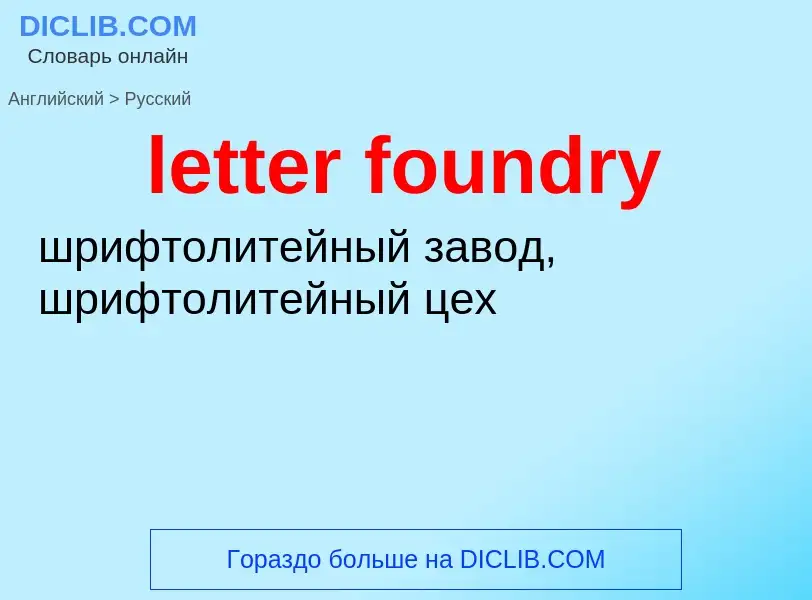Перевод и анализ слов искусственным интеллектом ChatGPT
На этой странице Вы можете получить подробный анализ слова или словосочетания, произведенный с помощью лучшей на сегодняшний день технологии искусственного интеллекта:
- как употребляется слово
- частота употребления
- используется оно чаще в устной или письменной речи
- варианты перевода слова
- примеры употребления (несколько фраз с переводом)
- этимология
letter foundry - перевод на русский
['faundri]
общая лексика
лигатура
литейная
литейное производство
литейный
цех литейный
металлургия
завод литейный
строительное дело
литейный завод
литейный цех
существительное
общая лексика
литейная
литейный цех
литейная, литейный цех
литье
полиграфия
словолитня
['kʌvənəut]
страхование
временное свидетельство о страховании (выдаваемое брокером страхователю)
Определение
)
Википедия

Bell is the name given to a serif typeface designed and cut in 1788 by the punchcutter Richard Austin for the British Letter Foundry, operated by publisher John Bell, and revived several times since.
The Bell typeface has a precise appearance that features stylish contrasts between thick and thin strokes and ball terminals on many letters; it was influenced by the radical Didone styles of type becoming popular on the continent, in particular the work of the Didot family. However, it is less severe in design, somewhat similar to the earlier Baskerville and slightly later Bulmer typefaces. The figures are distinctive for being at fixed height, or lining, at approximately three-quarter the height of the capitals, in contrast to earlier numerals of variable height. The figures have a number of elaborate details reminiscent of the steely calligraphy of the period, and the slight inclination of some of them led Walter Tracy to suggest that Austin was following a written example. In italic, like Baskerville, several letters have flourishes.
After a short initial period of popularity, the face fell into disuse in Britain and Austin's later typefaces are quite different in style, although copies in the United States became popular around the early twentieth century with artisan printers. Its history was studied by the historian Stanley Morison in the late 1920s and early 1930s, whose employer, the Monotype Corporation, created a 1931 revival, particularly popular for printing on high-quality paper. Morison praised Austin for his "exceptional technical gift" and described his Bell typeface as "surpassing all previous English and continental type-cutting in precision [and maintaining] independence equally against Bodoni and Baskerville".
Besides the digitisation of the Bell face by Monotype, an alternative professional adaptation of the Austin face in optical sizes by Paul Barnes and others under the name of "Austin" is available sold by Commercial Type. As of 2017, it is used by The Daily Telegraph among others. Austin's original matrices came into the possession of Stephenson Blake, and are now in the Type Museum collection in London.


![An 1808 share certificate for the [[Kennet and Avon Canal]], using the Bell type or one similar to it. An 1808 share certificate for the [[Kennet and Avon Canal]], using the Bell type or one similar to it.](https://commons.wikimedia.org/wiki/Special:FilePath/Kennet and Avon Canal Navigation 1808.jpg?width=200)

![A Foundryman, pictured by [[Daniel A. Wehrschmidt]] in 1899. A Foundryman, pictured by [[Daniel A. Wehrschmidt]] in 1899.](https://commons.wikimedia.org/wiki/Special:FilePath/A Foundryman, Daniel Albert Wehrschmidt, 1899.jpg?width=200)



